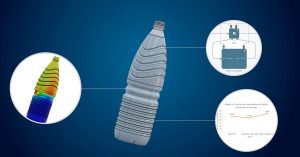Have you been to the SIMULIA Community lately? If you want the best content, access to our verified SIMULIA experts, a forum to ask questions, and more, then this is the place for you! Our community is engaged and informed about the latest in simulation trends, as well as providing solutions to complex engineering problems. And if you want access to Best Practice documents like Using the Physics Simulation Adapter in Process Apps, all you need to do is join for free!
This is the third post in a series of SIMULIA Community Best Practices featured on the blog. Come back for more posts about SIMULA Best Practices and other interesting simulation content.
Read the first Best Practice blog, here. And the second one, here.
The ‘Physics Simulation’ adapter is an application adapter in the ‘Optimization Process Composer’ application. This adapter allows a user to execute the simulation objects created in the ‘Physics Simulation’ application via a Simulation Process in the ‘Optimization Process Composer’ application. Using this adapter, the user can change the 3DEXPERIENCE parameters that are input to the simulation object, such as dimensions, load, etc., and execute the simulation object. After the execution, the ‘Physics Simulation’ adapter captures the output parameters, field plots, history plots, etc. 
The ‘Physics Simulation’ adapter provides options to execute the simulation object in various execution modes such as Single Solve, Iterative Solve (low disk usage), and Iterative Solve (high disk usage). Executing the simulation object with the ‘Single Solve’ mode saves the simulation results in the simulation object. In contrast, executing the simulation object with the ‘Iterative mode’ does not save the simulation results in the simulation object. Lastly, the execution mode ‘Iterative mode (high disk usage)’ provides options to create new branches of the original simulation object for each run. This execution mode is a good choice to perform other operations on the new branches downstream, such as Performance Trade-off analysis, Results Analytics, etc. The ‘Physics Simulation’ adapter also offers options to speed up the execution time, such as selecting the number of cores, and running the job in a persistent session.
This document explains the best practices to configure the ‘Physics Simulation’ adapter with the simulation object using two examples: hook design and bottle top load compression analysis. The document also covers various ways of troubleshooting execution issues based on the type of the execution failure by providing variables that can be defined to capture particular logs to identify the cause of the execution failure.
Target Audience: Simulation Expert, Method Developer
In this Best Practice, you will learn about:
- Advantages of mode selection for the execution
- Branching of the Simulation Object and its Lifecycle
- Best practices for configuring the adapter
- Best practices to troubleshoot the adapter related issues
Looking for more Best Practices? Get them HERE.
*Please note that you will need a valid DS Passport account with appropriate user role to access Best Practice Documents. Please contact your Dassault Systèmes representative for issues related to your account.
SIMULIA offers an advanced simulation product portfolio, including Abaqus, Isight, fe-safe, Tosca, Simpoe-Mold, SIMPACK, CST Studio Suite, XFlow, PowerFLOW and more. The SIMULIA Community is the place to find the latest resources for SIMULIA software and to collaborate with other users. The key that unlocks the door of innovative thinking and knowledge building, the SIMULIA Community provides you with the tools you need to expand your knowledge, whenever and wherever.


